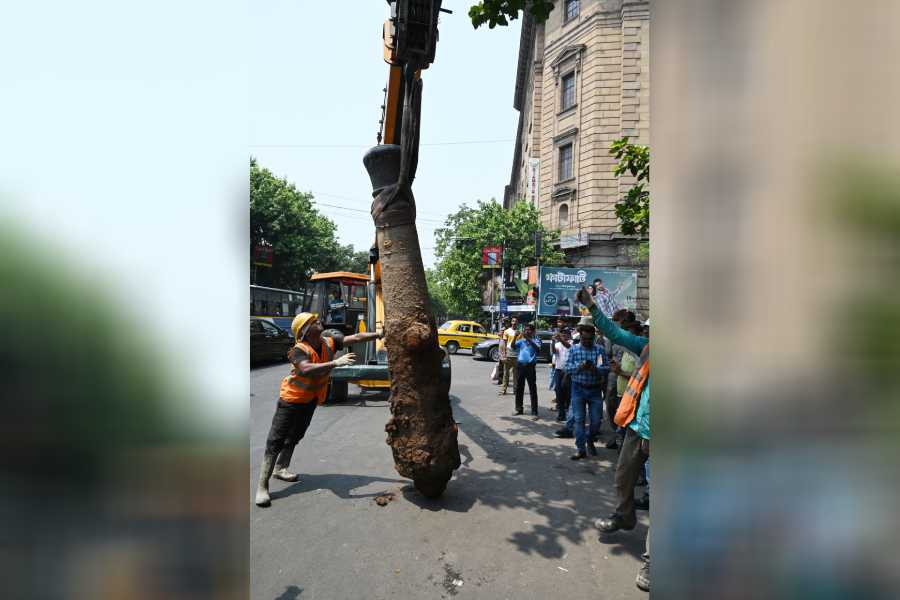A “British-era cannon” was pulled out from around 9ft below the pavement surface at the Fairlie Place-Strand Road intersection on Wednesday afternoon.
The dig had started late last week and had to be suspended for a couple of days as the cannon had a mesh of power cables and a high-tension wire wrapped around it.
On Wednesday, a weight-bearing strap was wrapped around the muzzle of the cannon, which in turn was connected to a hydraulic crane. The crane took around 15 minutes to pull out the 10ft-long cannon, which weighs in excess of 2,000kg.
As the cannon was being pulled out, a curious crowd of office-goers who had stepped out for lunch and commuters gathered around the spot, a stone’s throw from the headquarters of Eastern Railways at Fairlie Place.
Traffic personnel had to keep the crowd at bay as many wanted to take selfies with the cannon.
The cannon was taken to the New Secretariat building, around 1km away, where it will be restored.
Biplab Roy, administrator general and official trustee of Bengal, who was supervising the dig, said a team of experts led by him and Amitabha Karkun, a war history and firearm enthusiast, and some labourers will clean the cannon with soft brushes.
The next step will be to remove the dirt using a chemical solution from the sections where the date and place of manufacture and the name of manufacture are generally engraved.
Roy said such cannons have markings at three places, mentioning the date and place of manufacture and the name of the manufacturer.
“These markings are generally engraved near the firing hole at the rear of the cannon. Some have markings and engravings along the barrel for a few inches…. We need to remove the coat of mud and soil before we can get to those markings,” said Karkun.
Once the markings are visible and the date of manufacture is ascertained and recorded, Karkun’s team will start restoration.
“Since this cannon did not have a gun carriageway, the entire process will take around 15-20 days at the most,” Karkun added.
On Wednesday, a team including representatives of the Kolkata Municipal Corporation and CESC, and around a dozen labourers were at the spot since the morning. They dug around the spot where the cannon was buried in a way that the crane could lift it safely.
Karkun said the cannon seems to be a British-era 24-pounder gun. Its bore, he said, had become wider probably because someone had tried to saw off the portion that was sticking out of the pavement.
During the inspection, the team ascertained the bore to be around 6.45 inches. Although the exterior of the cannon was caked in mud, it seems to be in good shape. An initial inspection revealed it has not rusted, Karkun said.
The team also found under the pavement a concrete plate, into which at least 10 inches of the cannon had been sunk to make it stand vertically.
“Since this was mounted, we are quite sure that it had been propped up as a sentinel piece. Since this area is quite close to Fort William… it is not unlikely that it had been mounted as a war history monument or a sentinel piece,” said Roy.
“It seems the cannon could fire shots weighing 24 pounds at a distance ranging from 700 to 1,200 yards depending on the amount of gunpowder used and the elevation of the barrel,” said Karkun.
“Such 24-pounder guns were considered to be heavy artillery pieces that had a better range compared with other cannons of the time.”
Once the restoration is complete, the cannon will be kept at New Secretariat, where it will join the 10.5ft-long, 31-pounder cannon manufactured in 1796. It was excavated from near the Dum Dum Central jail.
The markings revealed that the gun dug out from near the jail was a Blomfield cannon, named after its designer Thomas Blomfield, who was the inspector of artillery and superintendent at the Royal Brass Foundry in Britain.
In the past few years, Karkun’s team has restored five cannons, which are all kept in the office of the administrator general and official trustee of Bengal at New Secretariat.
One of the five cannons is of Dutch origin and found in Chinsurah, Roy said.
